Multi-modal with MOTU: Transit Talk with SEPTA

Multi-modal with MOTU is a new, occasional Eyes on the Street series where we meet up with planners from the Mayor’s Office of Transportation and Utilities (MOTU) to explore the city’s infrastructure. We’ll talk shop about what MOTU is doing to rethink and improve how people get around the city. We’ll visit recent projects, examine pinch-points, and learn about work ahead.
For our first foray into MOTU’s multi-modal world, Eyes on the Street talked shop about changes to the city’s bike infrastructure in a two-part story on two wheels. [Part 1] [Part 2] This time, I hung out with planners from SEPTA and MOTU to talk about how they’re collaborating to improve Philly transit despite tight budgetary constraints.
———
On a hot Friday several weeks ago I cooled off at a table in the lower lobby of SEPTA HQ at 1234 Market Street. Sitting across from me was Charlie Webb, SEPTA’s Chief Officer of Service Planning, and Trish Ellis, MOTU’s Transit Policy Planning Advisor (and former SEPTA planner). Along with SEPTA’s press officer, Andrew Busch, Trish and Charlie graciously agreed to explain how SEPTA and MOTU work together to speed and improve transit in the city.
To the dulcet tones of soft rock and children running wildly into the vintage trolley in the lower lobby, we talked about the increased demands on SEPTA’s legacy system, SEPTA’s fixed operations budget, and the ways that the city and SEPTA collaborate. After our chat, we took a ride on the El and Route 52 bus to talk about the “Transit First” initiative, check out a route change, and visit the new Parkside Bus Loop. These changes are not grand urban gestures, but they do represent an era of cooperation and the persistent quest to improve city transit.
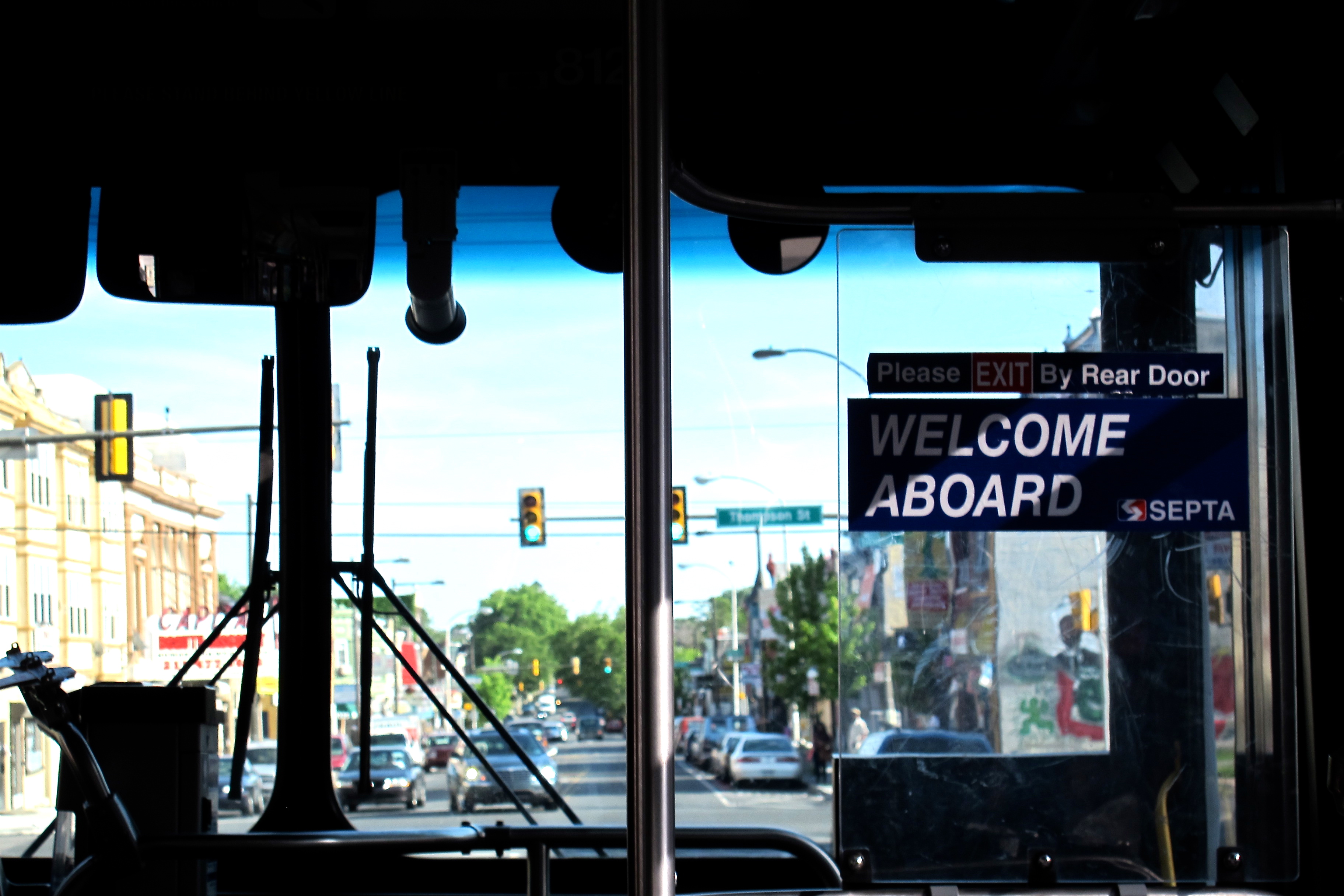
SEPTA Squeeze:
SEPTA was recently named the best transit system in North America. Yes, our SEPTA, with its mighty 144 routes: two subway lines, 117 bus routes, three trackless trolleys, nine light rail and 13 regional rail lines that keep Philly moving. The sheer reach of our transit system, and its many modes, would be enough to make other cities with skimpier systems envious. But this vast network comes at a price: maintenance. So while transit boosters bat around big ideas like new lines – like light rail along Roosevelt Boulevard or the Delaware Waterfront – these high-ticket capital projects go well beyond what SEPTA and the city can fund without a significant cash infusion.
The good news: Ridership has hit a 23 year high [pdf], spurred in part by the rising price of gas and the bumpy, slumpy economy. As many commuters will attest: rush hour trains and buses are packed. And SEPTA has seen major growth in late-night and weekend ridership because of different shifts and employment patterns.
But that good news also means that SEPTA is under pressure because their budget isn’t changing to reflect the increased demand or strain on the system. Instead, SEPTA has been forced to raid its “rainy day fund” just to keep the wheels turning. Despite SEPTA’s successes, the threat of fare hikes or service cuts loom on the horizon unless something major changes. [For more on SEPTA’s tough times, see Daniel Denvir’s recent City Paper story.]
“We really are at a point with our funding that we have very limited resources,” Trish said. As much as SEPTA and the city would like to answer increased demand by, say, putting more buses on the road, they can’t. There aren’t any more buses. And there’s is no pot of gold at the end of the El.
Of SEPTA’s operating budget, Charlie Webb puts it bluntly: “It’s fixed.”
That means that SETPA and the city have little choice but to find ways to improve service without spending more money. This is a story about creative thinking fostered by constraint.
That’s not to say the folks at SEPTA and MOTU don’t have big ideas. These are people who have thought enough about bus loops to have favorites, able to see poetry in the humming activity of transit hubs, and know the name of roof-level windows for straphangers to see out of (“standee” windows). They are transit buffs, do-ers, and by necessity they are also realists. So their shared challenge is to comb through ridership data, work with private developers to incorporate transit into site plans, experiment with route changes to make sure transit is where riders need it to be, and find any and all wiggle-room for improvement.
“Most of my career has been spent making improvements through resource reallocation,” said Charlie. He has been with SEPTA for about 35 years.
“Resource reallocation” and hunting for efficiencies are the two big means for SEPTA and the city to make adjustments. That’s where Charlie and Trish come in. We begin our journey on the Market-Frankford El.
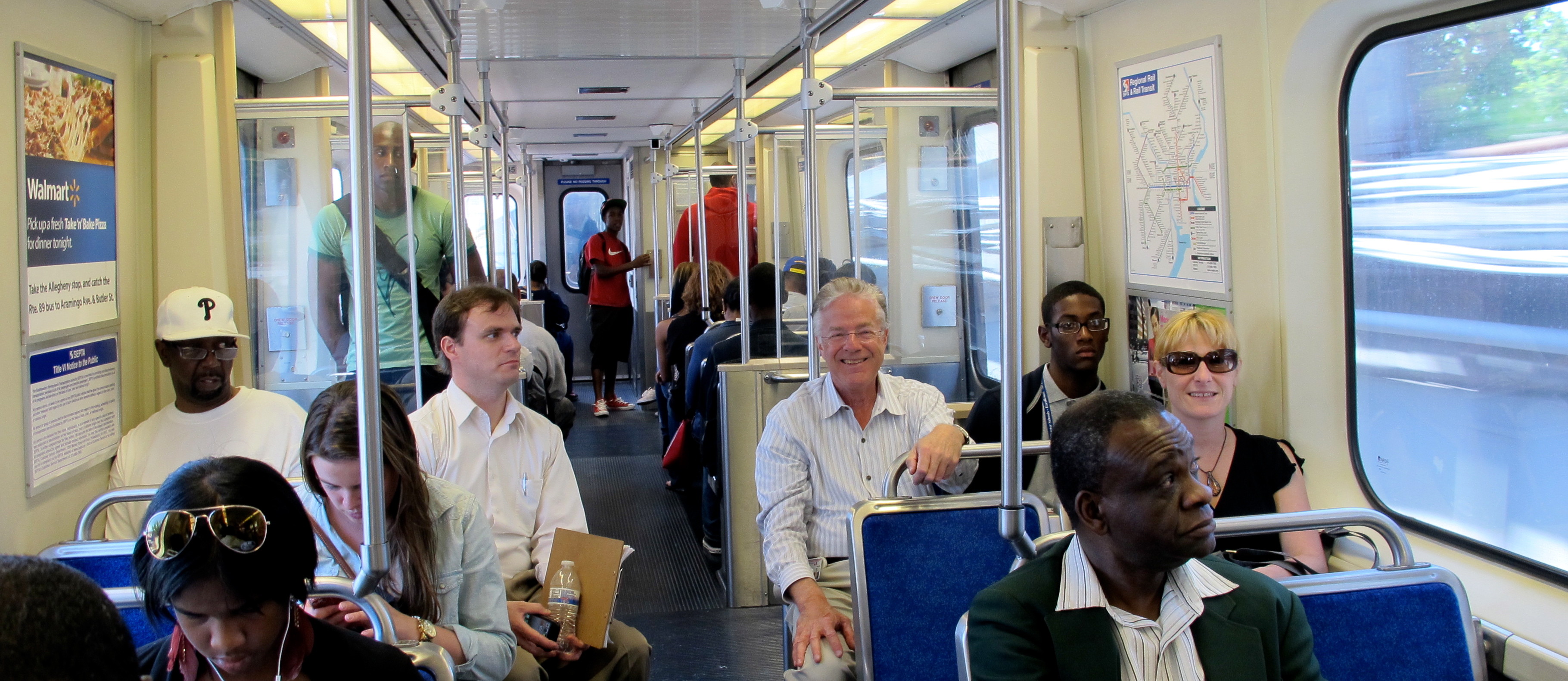
After chatting for about an hour at SEPTA HQ we set out from 13th Street – transit passes in hand – to talk about “Transit First” improvements, a route change, and visit the new Parkside Bus Loop.
We clicked through the turnstiles on the Market-Frankford Line and hopped right onto the arriving westbound train. In about 10 minutes we were standing at the corner of 52nd and Market, in the heat of a Friday afternoon.
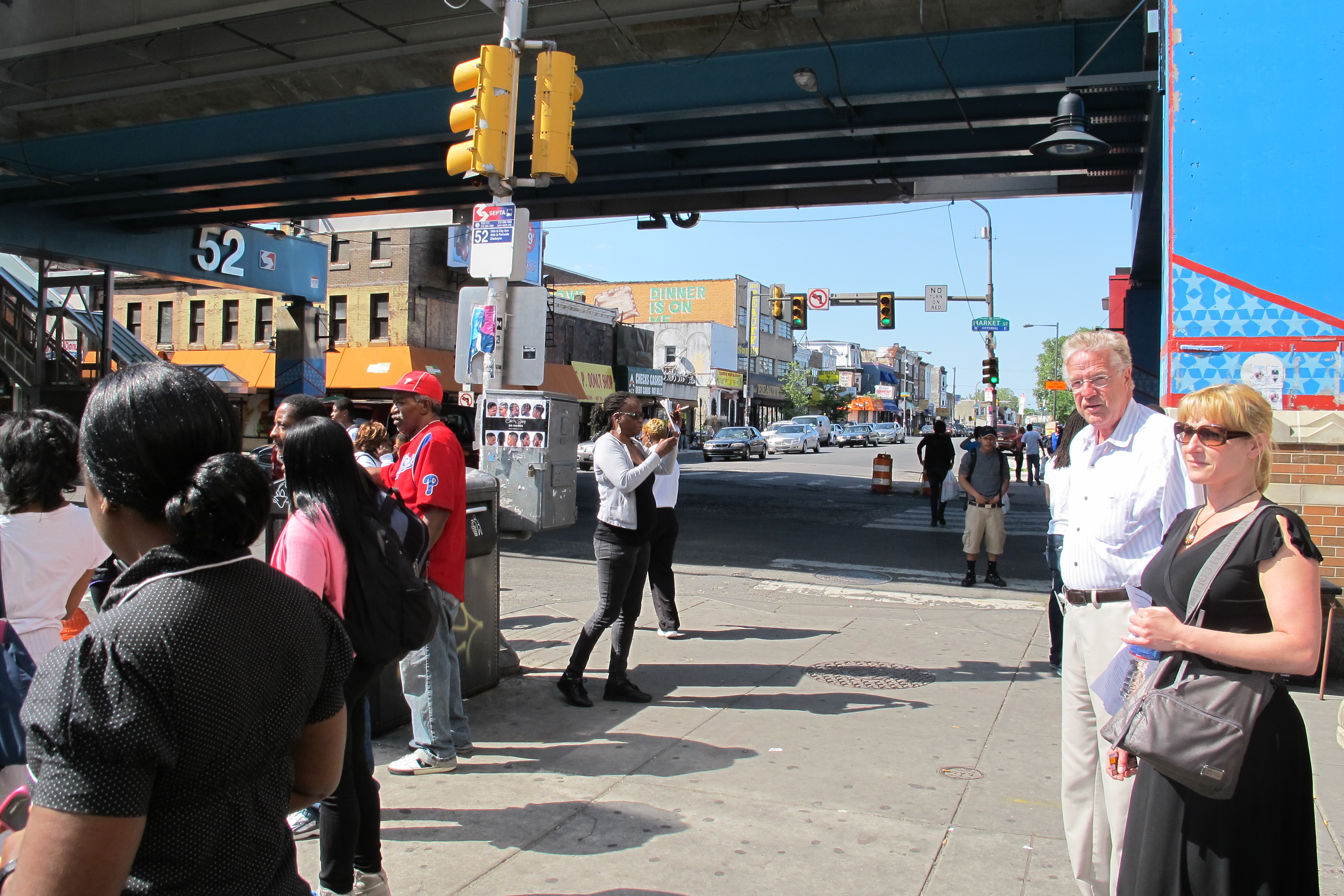
School was out, and the corners of 52nd and Market were bumpin’. Music blasted from car stereos and kids blazed through the busy intersection on ATVs, as load after load of subway passengers poured down the stairs to join the growing crowd waiting for the Route 52 bus in the sun. But the bus was nowhere to be seen.
A Route 52 bus finally appeared, but it was one that goes out to Gladwyne. We were hoping for the alternate Route 52 that heads into the Park West Town Center. We decided to pass on this bus, figuring ours couldn’t be too far off.
Transit First:
While we waited on the corner Charlie, Trish and I continued conversation about Transit First, a collaborative initiative between SEPTA and MOTU (along with committee members representing the Planning Commission, Police and Streets departments, and the Delaware Valley Regional Planning Commission) to streamline city transit service in ways that avoid a budget impact.
The hope is that by smoothing out as many operational snags as possible – getting stuck behind trash trucks, redundant stops, out of sync traffic signals – SEPTA can speed up service over the length of a route. MOTU is charged with inter-agency coordination, so these kids of operational issues are exactly the types of problems it can help SETPA resolve. In many ways Transit First improvements are a laundry list of small-scale adjustments that altogether can add up to better service.
Back at SEPTA HQ we had talked about one of the big, recent test cases for Transit First: the temporary Route 47 pilot project last year (which I happen to live along). As PlanPhilly reported, Route 47 Pilot Project tested stop consolidation (one every other block), tried some far-side stops (stops through an intersection), added rear-door loaders at busy hubs (to board passengers quickly), used a headway-based schedule, and worked with Streets to shift trash collection patterns to ensure that trash trucks were not on 7th and 8th streets during rush hour. While some changes (like trash pickup scheduling and rear-door loading) improved efficiency, most of the ideas didn’t shave off enough time along the Route 47 to become permanent. That had more to do with the street conditions (stop signs not traffic lights; a single lane of traffic) in South Philadelphia than the Transit First ideas. Charlie and Trish agree that the Route 47 Pilot Project was a successful learning experience that will inform similar Transit First projects on other routes.
Back in 2006 Route 52 saw some of the earliest Transit First changes: two stops were removed and more than two-dozen others were shifted to far-side stops. These moves cut 5 minutes off of each trip, but were not met with open arms by some community members. (But then it took a while for SEPTA to warm up to some Transit First ideas too.)
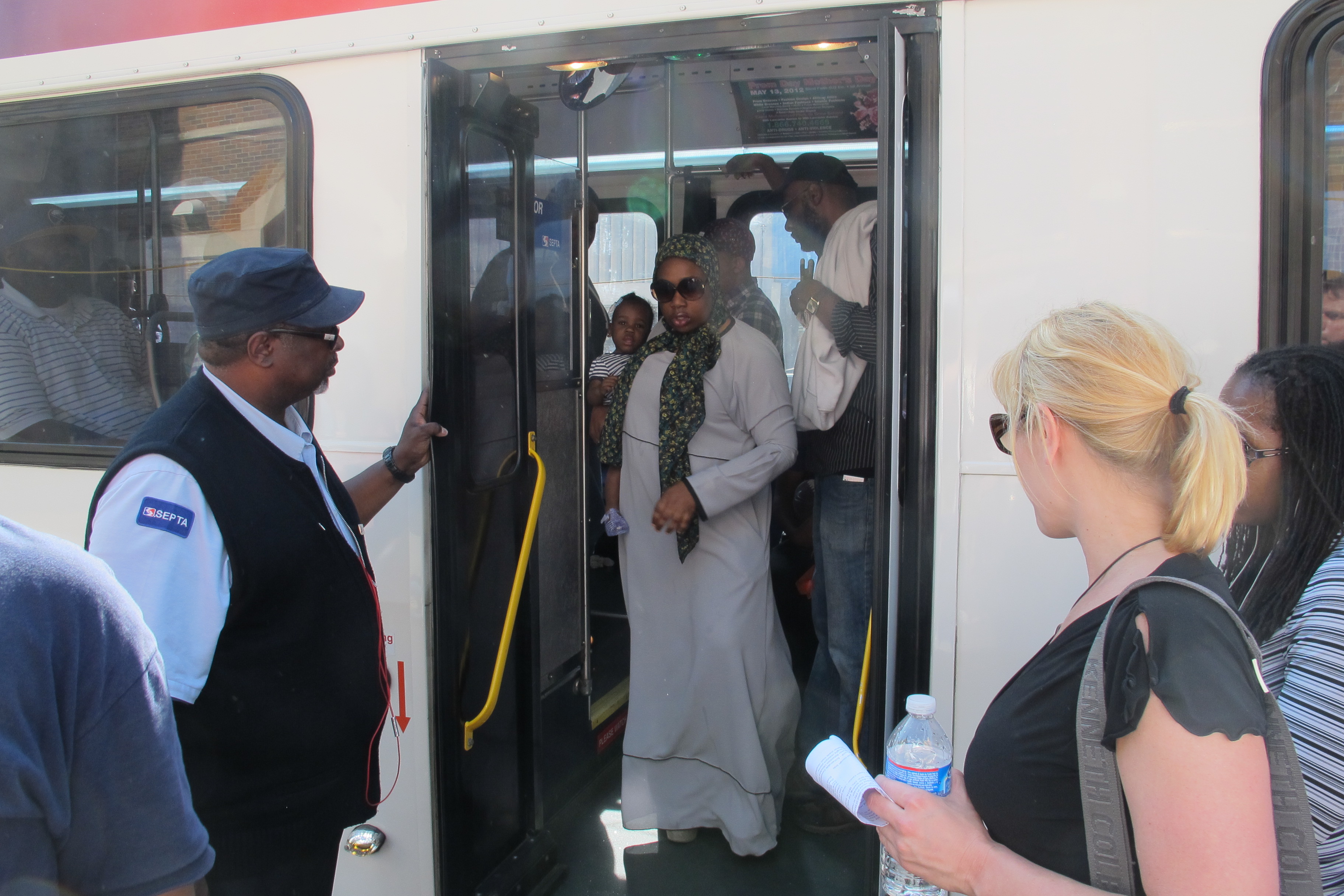
As we waited for our bus at 52nd a rear-door loader began his afternoon shift, standing curbside to check transit passes as passengers board the bus’ back doors. Trish explained that SEPTA and the city also recently implemented another Transit First idea on the Route 52: signal prioritization that enables communication between buses and traffic signals, thanks to a small federal grant.
Signal prioritization works like this: Say the Route 52 is approaching an intersection where the light is green light, an emitter on the bus sends a signal to a receiver on the traffic light to extend the length of the light if it’s already green. If there’s a far-side bus stop, the bus can continue through the intersection, pick up passengers, and keep moving.
SEPTA worked with MOTU to select corridors for signal prioritization where the traffic signals had been upgraded to ones that have a computer system. Trish explained that the pre-computer versions “have the equivalent of what looks like an egg timer.” The old egg-timer types are insular operations, but the new ones allow for the coordination of lights and transit, and are wired to SEPTA’s Control Center.
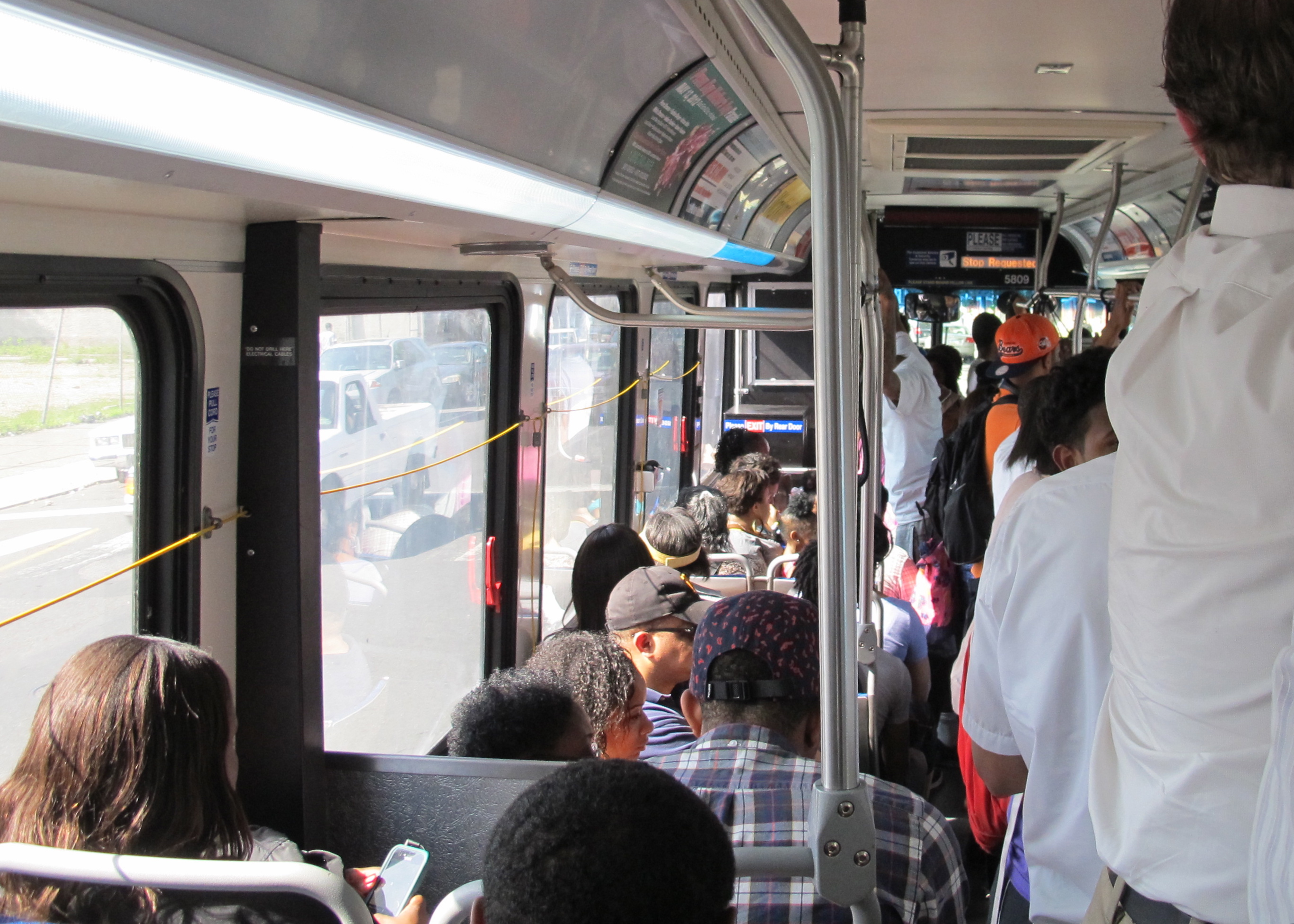
Waiting Game:
“Such very frequent headways, and this doesn’t feel that frequent now,” said Trish tactfully, looking down the block. By now we had waited about 15 minutes for our 52. So what do SEPTA and MOTU employees do when their bus is running late? They wait like everyone else, use a Smartphone to check the schedule and service alerts, and maybe flag down a SEPTA SUV looking for answers.
The stop at 52nd and Market didn’t have a new Stop ID number on the sign (coming soon to every stop), so we couldn’t text for the schedule. And a quick hunt on SETPA’s system status site revealed no alerts. Now about 25 minutes into our wait (albeit skipping one bus) our 52 arrived. We flashed our passes, boarded through the rear door, and headed north on 52nd Street, bound for the Park West Town Center.
As we rode along Trish and Charlie counted the far-side stops, talked about the relative merits of “standee” windows for straphangers, and discussed how positively contentious it can be to move a bus stop.
SEPTA-Private Partnerships:
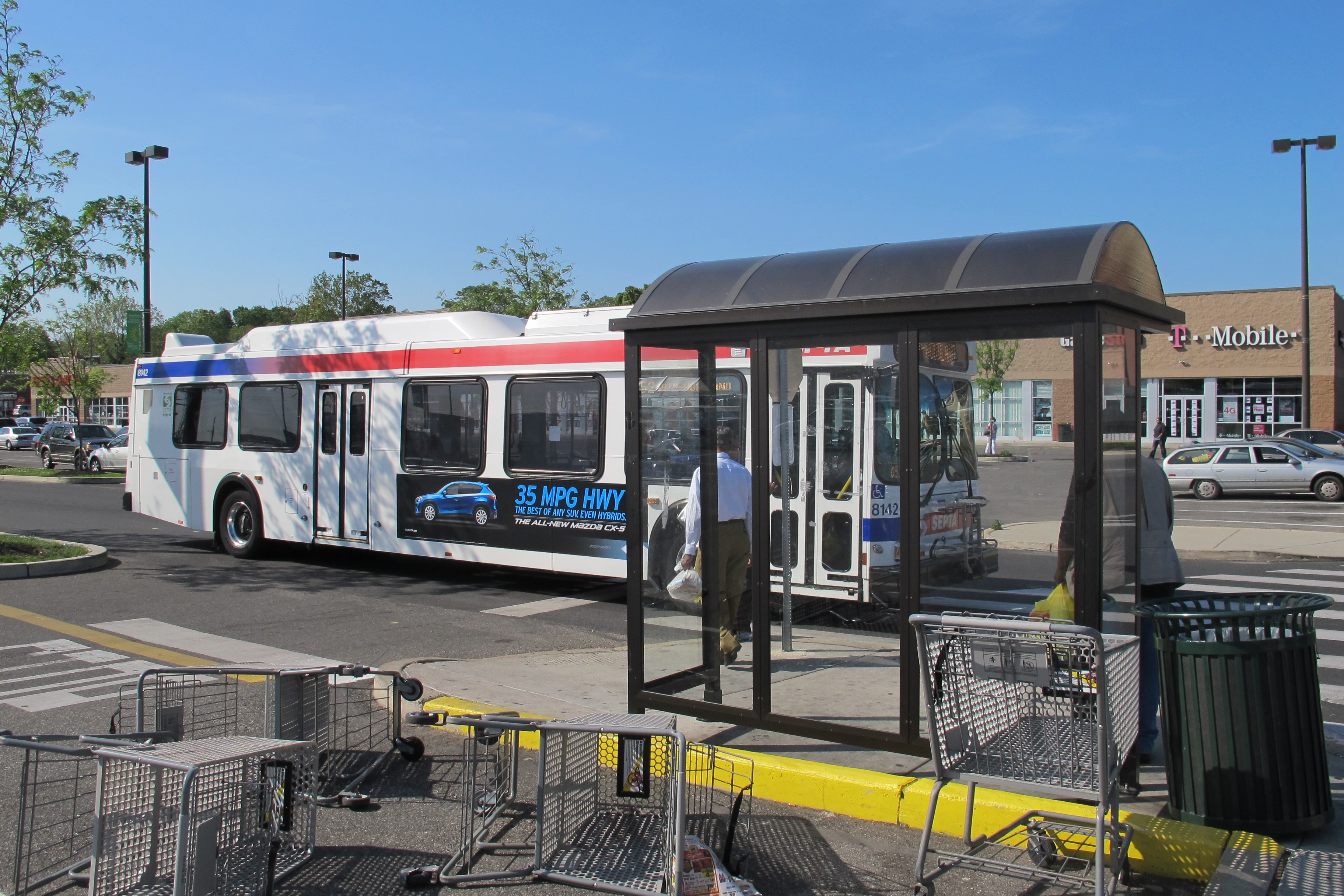
In minutes we hopped off the crowded bus in the middle of the Park West Town Center parking lot. This unremarkable space is actually a route-change victory that helped SEPTA capture more passengers.
The Route 52 used to stop outside of the shopping center, but now – thanks to the wishes of the very pro-transit ShopRite – some Route 52 busses come into Park West Town Center to better serve its shoppers and workers.
But retrofitting a parking lot to add a transit stop isn’t as easy as slapping up some signs and a bus shelter. In this case SEPTA wasn’t able to get into planning process early enough to integrate transit into the developer’s site plan. Bus stops require heavy-duty paving systems (tougher than your standard parking lot), enough room for a proper stop, minimal pedestrian and parking conflicts, and enough space for buses to maneuver.
But the retrofit has paid off. “[Ridership] has grown on Saturdays from about 350 when we were out on the street to over 700,” Charlie explained. On an average weekday 800 riders use the stop inside Park West Town Center.
The stop was so active that a canvasser was stationed there making sure people were registered to vote.
Next we beat a path beyond the parking lot to the new Parkside Bus Loop.
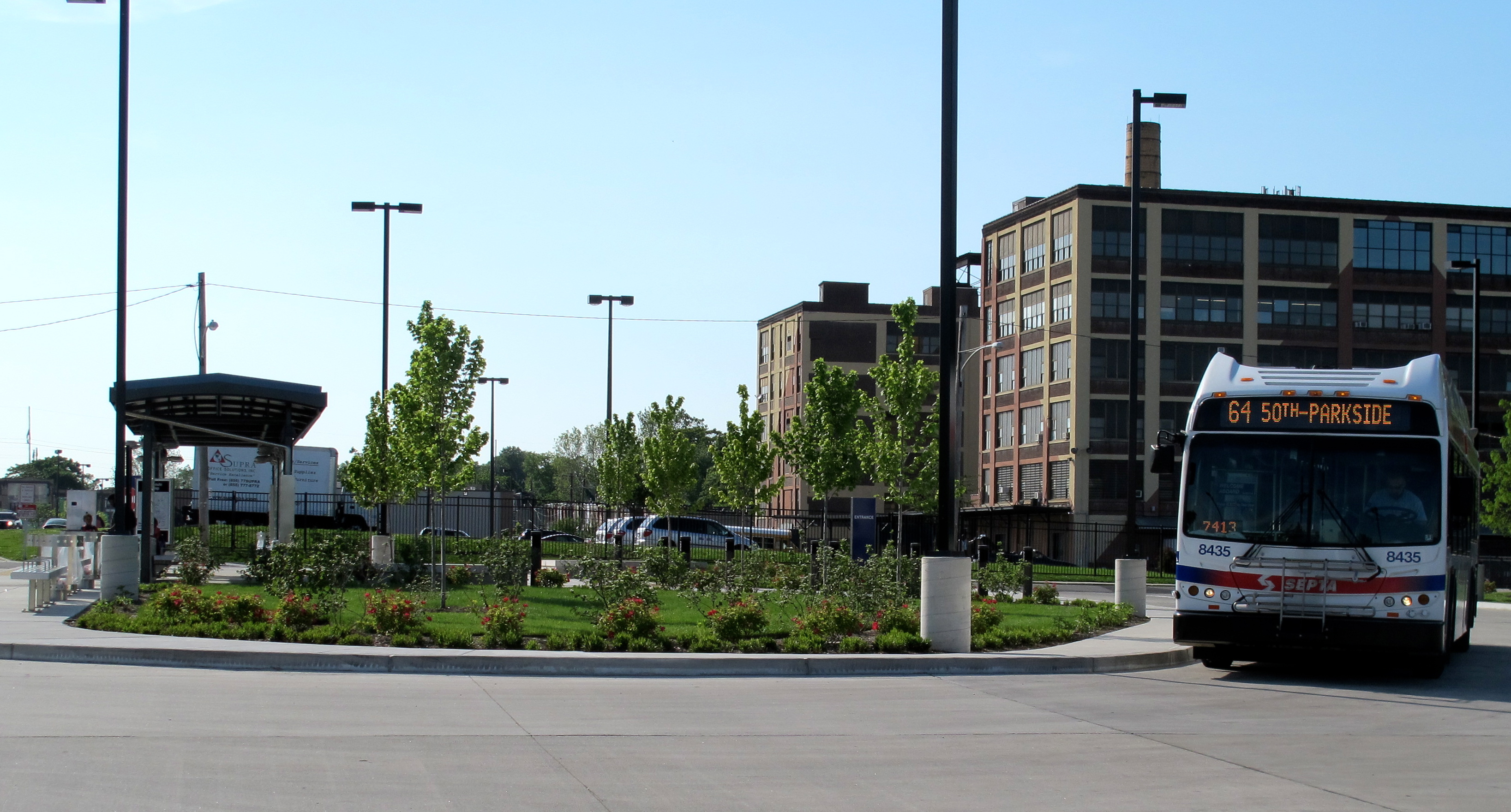
Parkside Bus Loop and Back:
“This has got to be the nicest bus loop we have,” Charlie exclaimed as we stood in the new Parkside Bus Loop, just behind the Park West Town Center, listening to birds chirp and hybrid buses whoosh to a stop. It’s a well-landscaped, new turnaround for the 40, 43, 52, and 64 buses that opened on 50th Street south of Parkside Avenue this year.
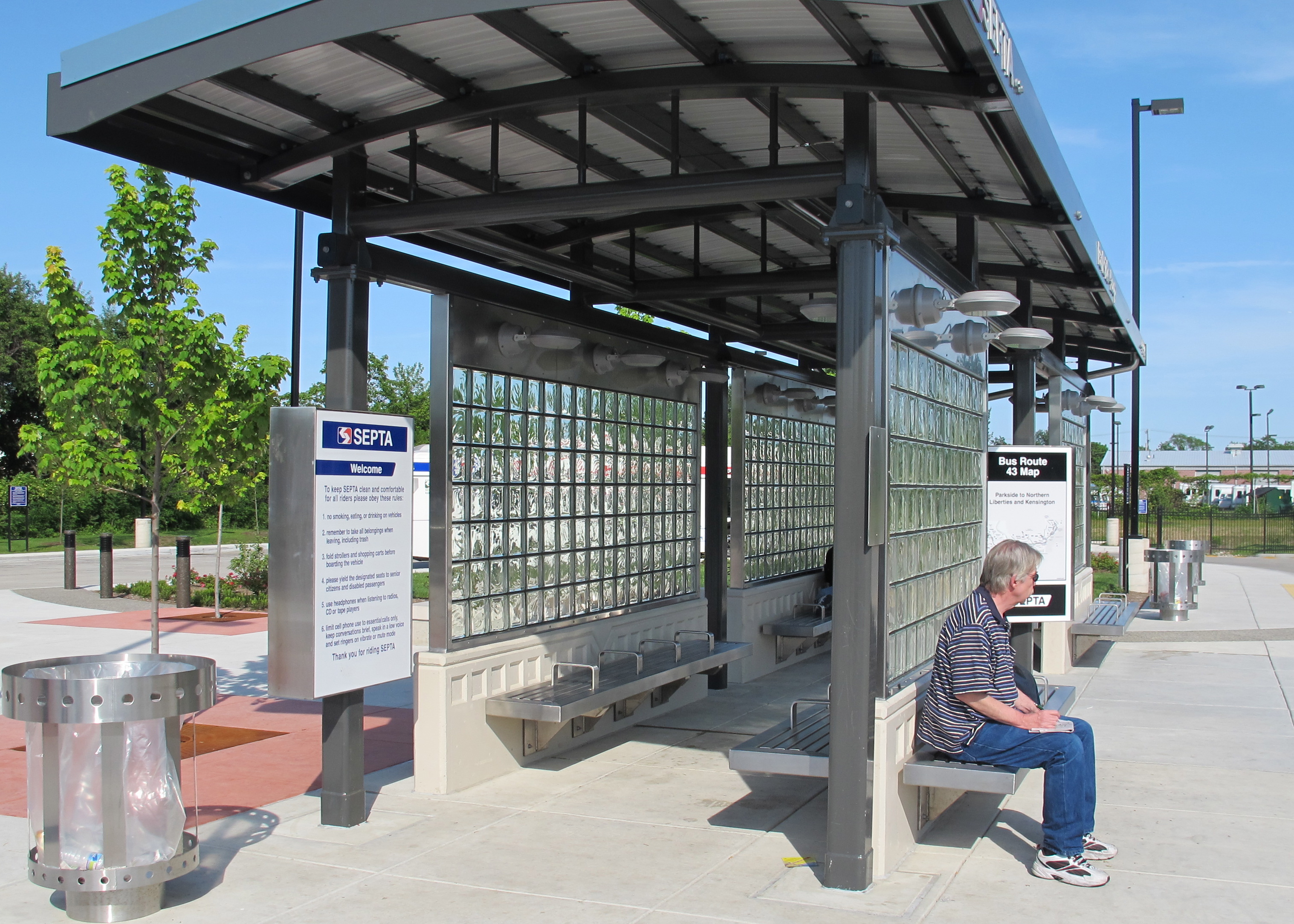
It’s not elaborate, but compared to the old space near 48th on Parkside – an old streetcar turnaround turned asphalt pad – the new loop has much better passenger and driver amenities, designed with the agency’s sustainability commitments in mind. The new loop features roses and drought-resistant plantings, new energy-efficient and solar-powered lights, a stormwater management system, a bus shelter built from recycled materials, and a new bathroom for SEPTA operators. The new loop was created on city-owned land thanks to a $2.2 million grant from the Federal Transit Administration.
Although my companions agreed that the new Parkside Loop is really nice, they debated whether or not Wissahickon – a more scenic location – is lovelier. After checking out the new maps (which hadn’t been updated to include the very loop we were at) and waiting in the shade of the new shelter, we headed back to the El on another 52.
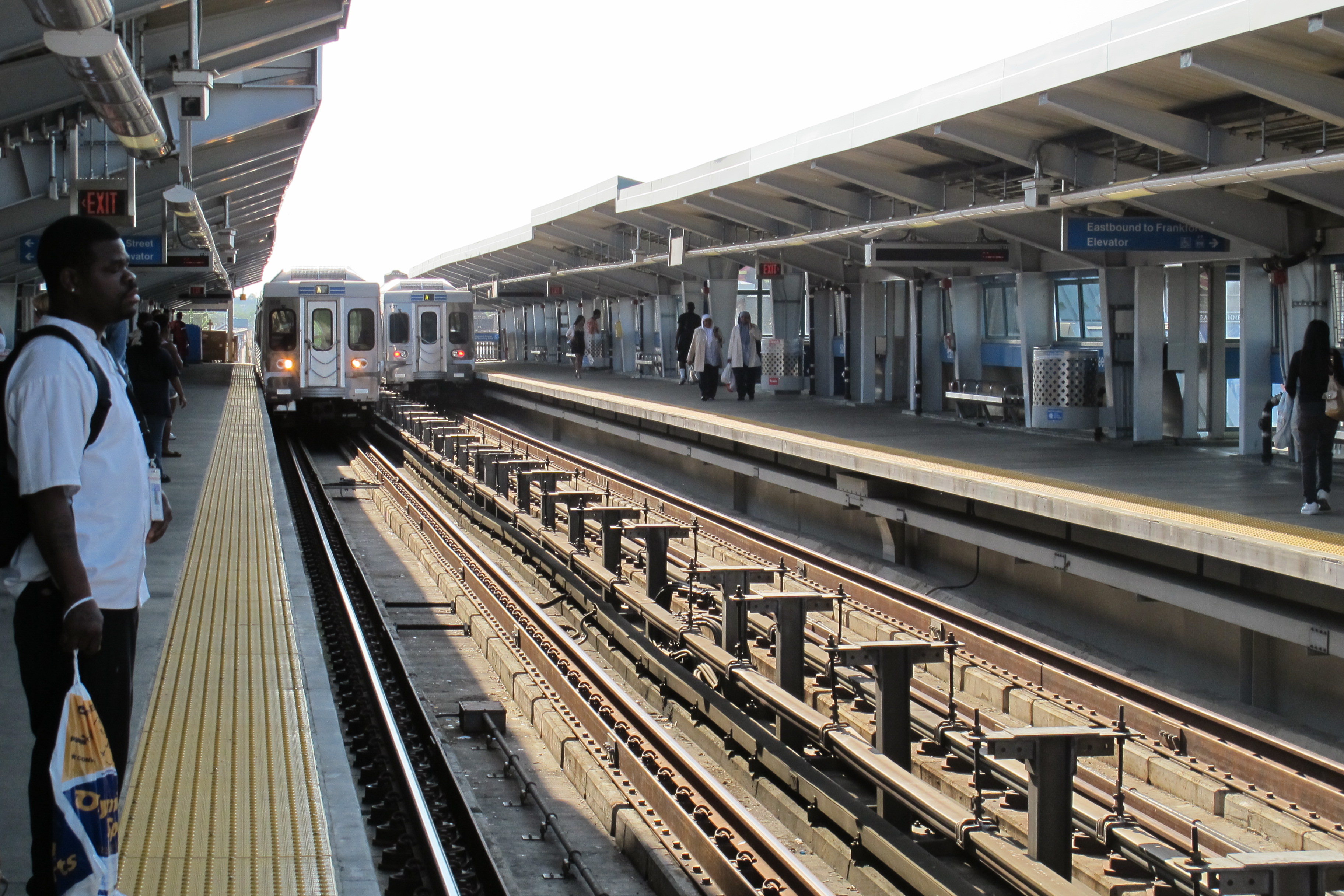
WHYY is your source for fact-based, in-depth journalism and information. As a nonprofit organization, we rely on financial support from readers like you. Please give today.






